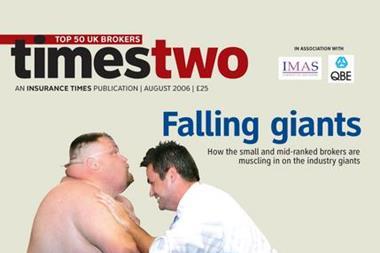Oliver Laughton-Scott selects the brokers who are batting for their shareholders.
The investor relations section of the Willis website starts with a very simple message: "All our actions are geared towards accomplishing one, overriding objective: increasing shareholder value. Joe Plumeri, chairman".
Plumeri has done a fantastic job since becoming chairman, though interestingly the share price in mid July 2006 is only just above what it was a year ago.
In contrast, Aon, which has struggled over the years to add shareholder value, is up some 35% over the same period. No clear picture emerges from the quoted sector. Benfield is up 27% and yet JLT has only increased some 2%, while Marsh went back 7%.
Smaller businesses tend to be more volatile and this is borne out in the sector, with THB up 42%, Windsor down 22% and Jelf, a newcomer, notching up 82%.
While quoted companies have a constant measure of shareholder value, private companies do not. So which management teams have been achieving Plumeri's overriding objective?
Jelf (1st)
Having listed on AIM at the end of 2004, its share price has increased by some 82% mid July 2005 to mid July 2006. A significant part of this increase happened when it purchased Goss in March this year and placed new shares with institutional investors. The transaction created significant investor interest and the shares jumped over 40% over this period.
The quoted markets are a tough place to be for small brokers. Without a string of successful acquisitions investors can rapidly lose interest and the apparent benefits of listed paper rapidly evaporate.
Jelf has subsequently made a couple of small acquisitions and needs to be careful not to spread itself too thinly. However, for a small company it has a relatively broad management team and much of its business is outside the general insurance market where competition for transactions is less intense. Consequently, Jelf should be able to continue to build shareholder value as it has done so emphatically over the last year.
Much of Jelf's business is not mainstream general insurance broking. However, its biggest acquisition in the year was Goss, a general insurance broker, and it is hard to argue with an 82% increase in the share price over the relevant period.
AA Insurance (equal 2nd)
After years of indifferent performances, with a change of ownership and top management, the AA has put in an excellent performance, growing its income organically by 25% while restoring its margins to respectability. While AA is one of the biggest brands, its target sector is highly competitive. It is possible its success in some degree reflects increasing customer confusion faced with a plethora of offers.
In June this year AA purchased Direct Choice. This is a significant development recognising that a strong brand can't cover the whole market so working with another non-competing brand can significantly broaden the organisation's reach. The willingness to work a number of brands targeted at particular customer segments has been a major driver of Admiral's great success and it is now being emulated by others.
Great brands can languish as M&S did, 25% organic growth in income is a real achievement in soft, competitive markets. The management are not resting on their laurels but developing a wider platform so they earn equal second.
Towergate (equal 2nd)
Towergate has posted a 39% increase in income, up on the prior year increase of 34%. However this year it has only moved up two places to No. 8 when in the previous year they moved up nine places. If Towergate continued to grow at a compound growth rate of 35%, in four years time it would have brokerage of over £550m making it larger than Aon. Consequently we expect the growth rate to tail off but one cannot accuse Peter Cullum of lack of ambition.
Winners last year and hard to ignore. But what about the exit? The larger the business grows the more likely it is to be flotation. The merger of Towergate and Folgate would also suggest this route.
All the insurers are terrified that another insurer will step up to the plate, but insurers' record of buying brokers has typically been pretty disastrous.
Which insurer Chief Executive would want to bet his job on such an acquisition? Equal second this year, but can Peter Cullum sustain the momentum? IT
Key indicators
- Growth: clearly a key factor. However, we are interested in increases in shareholder value; so if a deal costs more to finance (by debt and equity) than it adds in value, then the increased turnover will have actually destroyed value. So we are focused on organic growth and value added transactions, not simply growth in the top line
- Margins: we look at both the actual level achieved, but equally importantly at what the improvement during the year has been
- Peer performance: if a sector is putting in excellent results across the board, then this suggests the underlying driver is cyclical in nature; that is, the rating environment. The stock market is skilled at recognising the impact of cycles and tends to discount them accordingly
- Past successes: we are unlikely to pick the same company two years in a row as the winner. What we are looking for is the company that has added to shareholder value significantly in the current year.
The best of the rest
The following have all produced results that any management team would feel proud of. Insurance broking is a mature market and every pound of profit has to be fought for. They are listed in descending size order.
Willis: although its share price is back to where it started a year ago, Willis earns a place by pushing turnover up by 18% while the other big four are collectively 4% down (using a simple average). Having made a number of significant acquisitions in the period, organic growth can't be isolated. However, every senior executive at Willis is all too aware that lacklustre performance is something Plumeri does not tolerate.
Budget: Budget has not only increased its top line by 20% but more importantly it has significantly increased its margins to over 12%. It is working hard across the board to access markets, be it via its Direct Dial brand or its third party administrator, Junction, as well as making selected, typically small, acquisitions to build the core Budget business.
Oval: its ascent continues with brokerage increasing by 37% and profits doubling to £4m; we are taking it on trust that Philip Hodson will deliver the required bottom line to his equity backers.
Smart & Cook: with a 47% growth rate it is at the top end of the growth spectrum. However, it has not supplied a full profit and loss so it is not possible to see what value is being delivered to shareholders.
Hyperion: having achieved 44% growth last year, this year it achieved a comparatively leisurely 32%. Perhaps the slower growth in part explains why Hyperion doubled its profits before taxation to just over £4m. While the margin is less than 20%, it is successfully building an international broker and should reap the benefits of this over the longer term.
Highway Retail: Highway has made a decisive move into the distribution sector with a number of acquisitions, most recently MRB based in Romford. While personal lines is seen as the unglamorous end of the market, get it right and the rewards flow through to shareholders, not expensive employees. If Highway can grow to sufficient size and achieve economies of scale then it should be able to generate real shareholder value.
Lark Group: Lark has been following a consistent strategy of growing the commercial book in the South East and providing high net worth personal lines. This year has seen the business grow by 23% with a respectable margin of 15%. Lark is an excellent example of a company that has a simple strategy being well executed.
Hosted by comedian and actor Tom Allen, 34 Gold, 23 Silver and 22 Bronze awards were handed out across an amazing 34 categories recognising brilliance and innovation right across the breadth of UK general insurance.












































